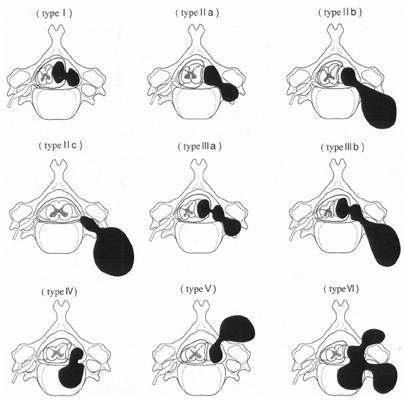Asazuma Classification
Asazuma et al. 1) devised a schwannoma classification system for cervical dumbbell-shaped tumors that consisted of nine categories. An important drawback of their classification system is that it cannot be used for thoracic spinal schwannomas or lumbar schwannomas, which are as common as cervical schwannomas.
Asazuma et al. classification system for dumbbell spinal schwannoma:
Type 1 intradural extradural restricted to the spinal canal. The constriction occurs at the dura.
Type II are all extradural, and are subclassified as:
IIa do not expand beyond the neural foramen.
IIb inside spinal canal + paravertebral.
IIc foraminal + paravertebral.
Type IIIa are intradural and extradural foraminal, IIIb are intradural and extradural paravertebral.
Type IV are extradural and intravertebral.
Type V are extradural and extralaminar with laminar invasion.
Type VI show multidirectional bone erosion.
Craniocaudal spread: IF & TF designate the number of intervertebral foramina and transverse foramina involved, respectively (e.g. IF stage 2 = 2 foramens).
Schwannomas involving C1 & C2: May involve vertebral arteries and require additional caution.
